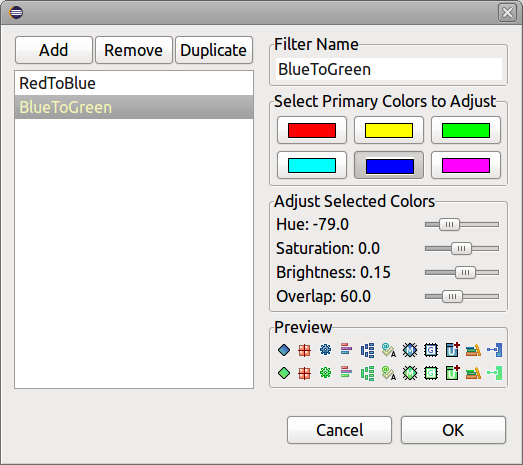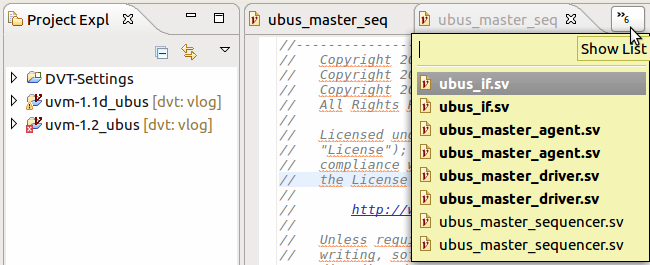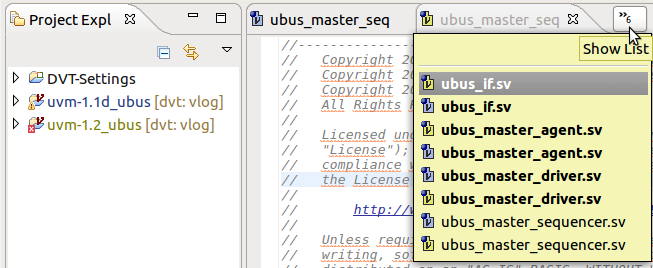Icons and Decorations
Icons

|
Regular VHDL File |
|---|---|

|
Linked Resource VHDL File See Linked Resources. |

|
Out of Project VHDL File The file is not inside a project directory, nor accessible as a linked resource. Functionality is limited on “gray” files. |

|
Library |

|
Package and Package Instance |

|
Package Body |

|
Entity |

|
Architecture |

|
Component |

|
Block |

|
Generate |

|
Function and Function Instance |

|
Procedure and Procedure Instance |

|
Input Port |

|
Output Port |

|
Bidirectional Port |

|
Port passed multiple times when tracing a signal |

|
Signal |

|
Variable |

|
Entity Instance |

|
Port connection |

|
Assign |

|
Process |

|
Component Instance |

|
Unknown Instance |

|
Type and Alias |

|
Enumeration literal |

|
Constant |

|
Generic |

|
Process |
Decorations
Compiled Files
To enable/disable go to Window > Preferences > General > Appearance > Label Decorations preference page and check/uncheck DVT Compiled File.

|
Compiled File |
|---|---|

|
Skipped File |
See also: Build Configurations.
Errors and Warnings
To enable/disable go to Window > Preferences > General > Appearance > Label Decorations preference page and check/uncheck VHDL Language * Error or VHDL Language * Warning.

|
Error |
|---|---|

|
Warning |
Trace Connections

|
Signal source |
|---|---|

|
Signal destination |

|
Signal source and destination |
Changing Icon Colors
To change the color of the icons in DVT, navigate to Window > Preferences and open the DVT > Icons preference page.

To change one or more icons select them in the tree and choose a filter from the drop-down list.
Once you are comfortable with the colors you chose, click Ok and you will be prompted for a restart to apply the changes.
There are six predefined color filters: Red, Yellow, Green, Cyan, Blue, Magenta. These filters change the predominant color of the selected icons into one of the six colors previously mentioned.
You can also create your own filters, by clicking the Edit… button. You will be prompted with a dialog that allows you to Add, Remove, or Duplicate custom filters.

To edit a filter, select it in left hand list, then modify the Hue, Saturation, or Brightness parameters in the right hand menu. These parameters will be applied only on the primary colors that are selected above.
The Overlap parameter indicates the hue interval size that will be modified.
For example, choosing to modify the red color with an Overlap of 180, will modify all the colors, since the hue interval is (-180, 180) degrees. An Overlap of 30 will only modify the colors in the (-30, 30) degrees hue interval around red.
Project Colors
When working on several files from multiple projects, it is hard to tell at a glance to which project each editor belongs.
Sometimes you might even have multiple editors with the same title (for example when each project is a different revision of the same design) which is particularly confusing.

Go to menu Window > Preferences then DVT and check Color editor icons per project and project labels.

Now all editors belonging to the same project have icons of the same color. Furthermore, the project labels in the Project Explorer have the same color, serving as a quick color legend.
Tip
You can chose to color the project labels text or background in the Project Explorer
Tip
To change the default color of a project Right-click in the Project Explorer and go to Project > Change Color
Note
By default a project’s color is computed using a hash function on the project name. This way you will get the same color for a specific project name, even if you switch workspaces or computers for example.
Note
This feature only works with Eclipse 4.x.